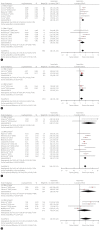Obesity and the risk of primary liver cancer: A systematic review and meta-analysis
- PMID: 33238333
- PMCID: PMC7820201
- DOI: 10.3350/cmh.2020.0176
Obesity and the risk of primary liver cancer: A systematic review and meta-analysis
Abstract
Background/aims: In this systematic review and meta-analysis, we aimed to clarify the effect of obesity on the occurrence of and mortality from primary liver cancer.
Methods: This study was conducted using a systematic literature search of MEDLINE, EMBASE, and the Cochrane Library until November 2018 using the primary keywords "obesity," "overweight," "body mass index (BMI)," "body weight," "liver," "cancer," "hepatocellular carcinoma," "liver cancer," "risk," and "mortality." Studies assessing the relationship between BMI and occurrence of or mortality from primary liver cancer in prospective cohorts and those reporting hazard ratios (HRs) or data that allow HR estimation were included.
Results: A total of 28 prospective cohort studies with 8,135,906 subjects were included in the final analysis. These included 22 studies with 6,059,561 subjects for cancer occurrence and seven studies with 2,077,425 subjects for cancerrelated mortality. In the meta-analysis, an increase in BMI was associated with the occurrence of primary liver cancer (HR, 1.69; 95% confidence interval, 1.50-1.90, I2=56%). A BMI-dependent increase in the risk of occurrence of primary liver cancer was reported. HRs were 1.36 (95% CI, 1.02-1.81), 1.77 (95% CI, 1.56-2.01), and 3.08 (95% CI, 1.21-7.86) for BMI >25 kg/m2, >30 kg/m2, and >35 kg/m2, respectively. Furthermore, increased BMI resulted in enhanced liver cancer-related mortality (HR, 1.61; 95% CI, 1.14-2.27, I2=80%).
Conclusion: High BMI increases liver cancer mortality and occurrence of primary liver cancer. Obesity is an independent risk factor for the occurrence of and mortality from primary liver cancer.
Keywords: Carcinoma, Hepatocellular; Liver cancer; Mortality; Obesity; Risk.
Conflict of interest statement
Figures




Comment in
-
Metabolic disease as a risk of hepatocellular carcinoma.Clin Mol Hepatol. 2021 Jan;27(1):87-90. doi: 10.3350/cmh.2020.0302. Epub 2020 Dec 3. Clin Mol Hepatol. 2021. PMID: 33317238 Free PMC article. No abstract available.
References
-
- Renehan AG, Tyson M, Egger M, Heller RF, Zwahlen M. Body-mass index and incidence of cancer: a systematic review and meta-analysis of prospective observational studies. Lancet. 2008;371:569–578. - PubMed
-
- Goodwin PJ, Stambolic V. Impact of the obesity epidemic on cancer. Annu Rev Med. 2015;66:281–296. - PubMed
Publication types
MeSH terms
LinkOut - more resources
Full Text Sources
Other Literature Sources
Medical

